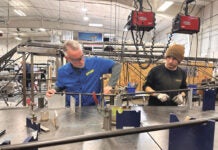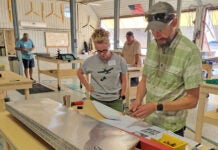Last week, just as I was girding to launch into the savage hinterlands of central Florida where Sebring is situated, I got a note from Sebastien Heintz, of Zenith Aircraft. At the Sport Aviation Expo, he wanted me to build a rudder from one of the company’s new match-hole kits because he wished to make a point that might not be obvious.
Match hole broadly refers to the process of pre-drilling aircraft parts before they’re formed and assembled as a means of increasing efficiency and improving quality during assembly. Match hole is not particularly new. I think I first saw it as early as 10 years ago. But what is new–or newer–is that heretofore, the holes were drilled undersize, the idea being that you gained alignment accuracy by enlarging the hole to the final rivet size in situ. Zenith’s new kits have holes drilled to the final size. Doesn’t sound like much of a difference, but when you’re drilling 5000 holes, it adds up.
And it’s a quantum leap over the older kit technology. Back in another age, I built the tail section of a Van’s RV-4. That kit came with raw metal parts, formed skins and drawings. I had to build a semi-elaborate wooden fixture to align the thing. The skeleton had to have some parts made from raw stock, holes drilled and deburred and rivets driven and bucked–few pop rivets. The rivets were countersunk and had to be bucked or squeezed. Bucked riveting is not a difficult skill to learn. Consistent bucked riveting is. It’s almost like an athletic skill that’s perishable. So my vertical fin had a nice, near perfect row or two of flush rivets, with a couple here and there with ugly half moons. I was better at drilling out bad rivets than setting good ones.
With match-hole to final size, the parts are self jigging and the accuracy is astonishing. When we laid the skins on the ribs, I peered down into the holes and saw nothing but air. I assumed this was because the rib was entirely off alignment and I’d need to reach in and fish it straight. Nope. The holes were so perfectly aligned that I couldn’t even see a fingernail clipping worth of metal in the mated part. Stick a Cleco in one end, then the other, and bang the rivets in. It takes more time to describe it than to do it.
The implications are obvious, as Heintz explains in the video. The latest in match-hole technology produces more accurate parts at lower cost and kit build time is reduced by two thirds. Furthermore. using SOLIDWORKS, a CAD-CAM standard, parts can be easily redesigned and, more important, lightened or improved.
Zenith believes that improved match hole will expand the pool of people who might consider building an airplane when they realize how accessible it can be. But to understand that, you actually have to try it which is why Heintz shrewdly invested in a rudder kit and had me build it. I think he’s right, although the potential market expansion is probably in the margins.
Diehard kit builders sometimes assume that people who buy airplanes are idiots for not building them instead, the argument being that a kit-built airplane is by far the better value. While it certainly can be, a fair reading of the economics paints a different picture because actually building an airplane is an undertaking many people won’t consider no matter how easy it is because they’re just not tool users. I asked Heintz what the all-in price for the CH750 Super Duty would be. On the low end, he thought $50,000 with a used engine to a high of $80,000. Ignoring the builder’s labor, that’s still a substantial investment. And the time and effort to build it, while dramatically less than it used to be, is still not trivial.
The Super Duty is basically a 100-knot airplane with terrific STOL capability, good payload and cabin volume and built like a truck. The avionics are what you make of them. On the certified side, that much money buys maybe a mid-1970s Cessna 182 of indeterminate provenance that goes a little faster and carries a little more, but is likely to be way more expensive to fly and maintain and has an avionics museum in the panel. You get to be your own A&P with an EAB airplane and if you built it, you can probably fix anything on it. Plus, it’s a new airplane; the Cessna isn’t. On the other hand, the Cessna might be easier to sell than any homebuilt.
The dealmaker for me would be the right airplane. I’m not interested in STOL, but I am interested in a fast two-place, go-places airplane. Think something like the Globe Swift but a little smaller, with retractable gear. And I prefer metal, so a match-hole kit like that powered by Rotax’s new 915 iS would get my attention over anything certified. I suspect that this engine may ignite just such a design, sooner or later. Because of the pricey engine, it would have a price nearer Heintz’s top end (if not above), but also a different slice of the market that’s between the Zenith products and the Lancair-type speed merchants. Even at $100,000, that’s a good value, albeit not a small investment. To be sure, the prolific Van’s line fits this design brief, but without the 915. (Yet.) That’s why Van’s is a market leader.
Kudos to the Vols
All of these shows run on an army of volunteers and this year, the Sport Aviation Expo had an outstanding corps of them. When I arrived early Wednesday, the press passes weren’t ready, but the nice lady at the booth acted as a strategic corporal and handed me an exhibitor pass so I wasn’t delayed. I love improvisation.
Later in the day, I flagged down volunteer Wendy Amos in a golf cart to locate the press person for the event. Thirty seconds later, I was hooked up. Lots of times, I’ve heard volunteers say “I don’t know” or “you’ll have to check with so-and-so.” One and done is a refreshing change.
This show is famous for occurring during Florida’s worst winter weather. This year, it wasn’t cold, but it got gusty on Thursday. As my camera case was being blown slowly across the ramp, a vendor I was speaking to asked, “Can you believe these guys are flying the Tri-Motor in this?” And “this” was gusting to 27 knots. But they sure enough were still offering rides. I’m not sure I would.
Do we really want people like this in aviation? This is a rhetorical question and don’t ponder it unless you’re prepared for the answer: Yes.













